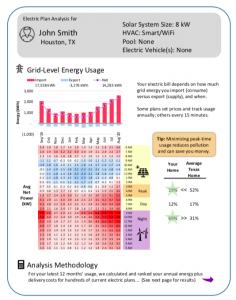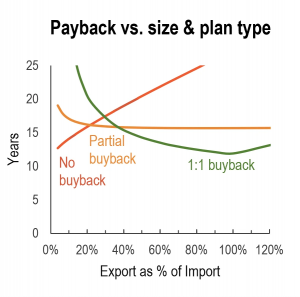Earning bill credit for excess solar generation in Texas

When your solar system produces more electricity than your home uses, the excess electricity is sent out through your electric meter. Your neighbors use this extra electricity.
In most places, solar homeowners receive a credit on their monthly utility bill for this excess electricity their system produces. When the excess generation is credited at the same rate as the customer’s consumption this is known as net metering. It ensures solar homeowners receive fair credit for the electricity their systems generate and helps them see a return on their investment into solar.
Net metering policies are enacted at the state level. Thirty-eight states require utilities to offer net-metering.
Texas is not one of them.
However, Texas solar owners have other options to get value from their surplus generation.
If you live in a municipal-owned or rural electric cooperative utility-service area, check with your city or cooperative about their solar buyback program. Many municipal utilities and electric cooperatives offer credit for excess generation. If yours does not, or if you are unsatisfied with the rates, these publicly managed utilities should be responsive to your concerns. Check out these resources for advocating within a muni or co-op.
If you live in an area where you must choose your Retail Electricity Provider (REP), you may have several buyback options available.
Solar buyback programs: Considerations if you can choose your Retail Electricity Provider
Some REPs offer solar buyback plans that credit solar homeowners for the electricity they generate. Current rates and terms vary from provider to provider. The best one for you will generally depend on three factors:
- How much electricity you import from the grid
- How much surplus solar electricity you export back to the grid
- When (what time of day) you import/export electricity
Solar United Neighbors has partnered with Texas Power Guide to help current and prospective solar owners find the plan that maximizes their array’s value. If you reside in the Centerpoint or Oncor utility service areas, request your free custom analysis now.
We’ve helped hundreds of people select the right plan to maximize their solar savings and when we analyzed the results, we found that solar homeowners can save $390 on average if they select the right plan.
Below are sample simple payback rates (in years) based on the amount of solar energy exported and the retail electricity plan type. Most solar owners on a plan type that complements their system will see a simple payback in 15 years.

**1:1 Buyback plans (green line): These plans charge you for imported grid energy and credit you for surplus exported energy at the same fixed rate (¢/kWh). If you export more than you import, bill credits rollover to the next month. Depending on rates, this type of plan is generally best if your solar system exports at least half as many kWh as you import, with simple payback decreasing the closer you get to a 100% export ratio
**Please note, as of 12/2021, 1:1 buyback plans are no longer offered by any retail electricity providers in the state.
Partial Buyback plans (yellow line): These plans also credit you for surplus exported energy, but typically at a lower ¢/kWh rate than what you pay for imported energy. Depending on the plan, rates may be fixed or highly variable, and bill credits may or may not roll over to the next cycle. These plans tend to charge less for imported energy than “1:1 Buyback” plans, which is preferable if you don’t export much energy back to the grid (i.e. an export ratio of 20-40%).
No Buyback plans (orange line): If you are a solar owner who uses most of the energy you generate directly in your home and export very little to the grid, a standard or wholesale plan will offer the shortest payback. The smaller the export ratio, the more competitive this type of plan will be.
Notes:
- Electricity plan options as of 10/15/2021.
- “Export as a % of Import” means the percentage of electricity you generated and exported to the grid vs. how much you imported from the grid. Example: If you import 1000 kWh each month (you pay for them), 40% export means in that same month you sent back 400 kWh of solar energy to the grid (back through your meter). This value depends on both when you make solar energy AND when you use electricity in your home.
- Assumptions for simple payback include: $2.50/Watt install cost paid in cash, 26% Federal Tax Credit, 12 ¢/kWh pre-solar electricity rate. Solar output assumes Houston roof-mounted array, 180° azimuth, 20° tilt.
- Average Texas residential electricity consumption (~15,200 kWh/year) per ERCOT.
- All analysis depicts typical, pre-pandemic (COVID-19) electricity consumption patterns
